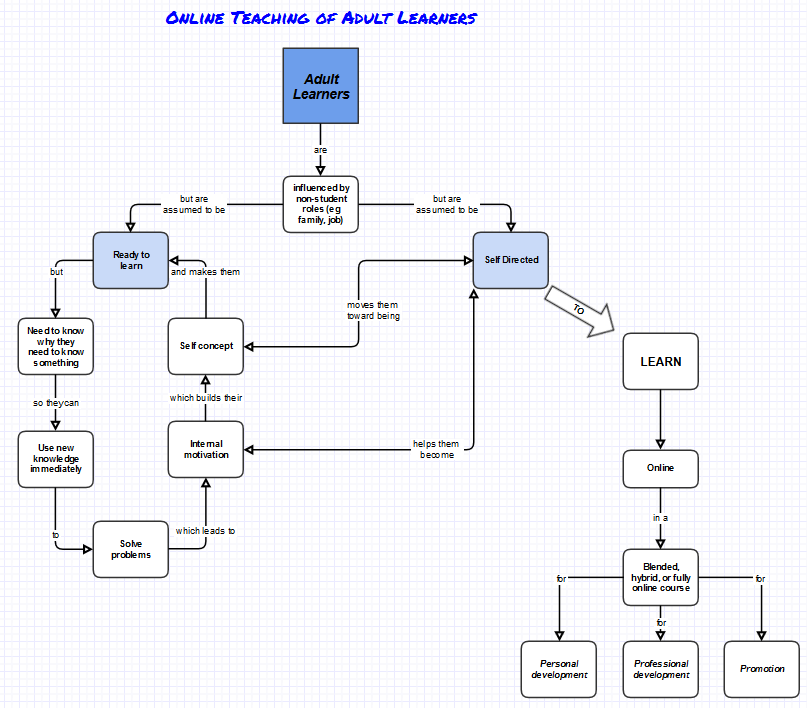Gerald Grow (1991) proposed the Staged Self-Directed Learning (SSDL) Model to describe “how teachers can actively equip students to become more self-directed in their learning.” He describes four student stages of self-direction and teacher roles for each of the stages. Stage one learners are dependent and the teacher’s role is one of authority or coach. Stage two learners are interested and have some self-direction. The role of the teacher is a motivator and guide. Stage three learners are involved. They have intermediate self-direction and will explore a topic if guided. The teacher is a facilitator. Stage four learners are self-directed. They set their own goals, identify resources, have time and project management skills, and take responsibility for their own learning. The teacher may not be needed at all but can be a delegator and consultant. Students view themselves as mostly equal to their teachers in this stage.
The stage of any student, including myself, is situational, as pointed out by Grow (1991, p. 127). I am stage four on things related to my primary career in medicine. I am responsible for my own continuing education. I am able to recognize knowledge deficits and develop a plan to correct them. I am able to independently choose the resources that will best help me achieve my learning needs. For some, if not much, of the MET program I am probably more stage three with some stage four towards the end of a course. Attitudinal, I am self-directed but need facilitation from the teacher as I do not know the content area enough to know what resources to use to achieve my learning needs and goals.
Grow (1991) outlines very nicely in his paper the role of the teacher for each stage and examples of teaching that would be best matched to each stage. As Grow notes, “problems arise when the teaching style is not matched to the learner’s degree of self-direction” (1991, p. 136). Thus, the main implication of this model is that the teacher needs to understand at what stage of self-directedness the majority of his/her students are in and match their teaching style and activities to the stage. I am not sure that I can differentiate a different andragogical approach between online teaching and face-to-face teaching other than the tools that would be used to match teaching approach and student stage. I think the activities would be similar but how they are facilitated might potentially differ online compared to face to face. For a stage one learner learning introductory material in a course, lecturing and drill with correction would be an appropriate approach. As students progress to stage two and the material is more intermediate a mixture of lecture and teacher led discussion would be appropriate with structured application of material. Stage three learners just need facilitated discussion and facilitated student projects. Stage four learners can work on independent projects, lead discussions themselves and only use the teacher to monitor the process and act as a consultant.
In the online course that I teach I can tell students progress from stage one to mostly stage three by the end. I provide a lot more supplantive scaffolding in the early modules of the course compared to later modules. I direct the discussion in early modules and leave it up to students to develop questions they want to discuss in later modules. Students have to solve teacher-generated problems throughout most of the course but for their final project they identify a real problem of their choosing and go through all the steps learned in the course to solve the problem, while demonstrating critical thinking skills. Until this week I had never realized that my course design facilitated progression through these stages.
Concept Map of Online Teaching for Adult Learners
An online version of this image without grid lines is available here.
Adult learners are influenced by their roles outside of being a student including family and job roles. Despite this they are assumed to be ready to learn and be self-directed. While adults might be ready to learn they need to know why they need to learn something. Adults want to use new knowledge immediately to solve problems. This leads to internal motivation building their concept of self which makes them ready to learn and become self-directed. Adults can learn online in hybrid, blended, or fully online courses. Unlike non-adults, adults tend to learn for personal development, professional development, or for job promotion.
I chose to focus on these concepts as they are the main assumptions put forward my Malcolm Knowles on androgogy or the theory of how adults learn (Merriam & Bierema, 2014). Furthermore, Knowles believed adults become more self-directed as they mature and that self-directed learning is a hallmark of adult learning.
References:
Grow, G. O. (1991). Teaching learners to be self-directed. Adult Education Quarterly, 41, 125-149.
Merriam, S. B., & Bierema, L. L. (2014). Adult learning: Linking theory and practice. San Francisco: Jossey-Bass.
